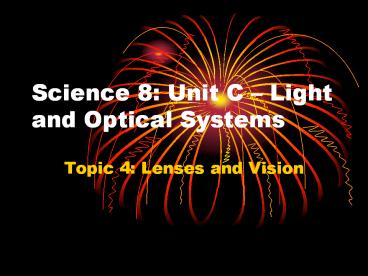Science 8: Unit C - PowerPoint PPT Presentation
1 / 13
Title:
Science 8: Unit C
Description:
Convex Lenses and Real Images A convex lens can ... Concave Lenses and Divergence Convex Lenses and Real Images Concave Lenses and Virtual Images The ... – PowerPoint PPT presentation
Number of Views:72
Avg rating:3.0/5.0
Title: Science 8: Unit C
1
Science 8 Unit C Light and Optical Systems
- Topic 4 Lenses and Vision
2
Convergence and Divergence
- Lenses through refraction cause light rays to
either - Converge light rays move together. or
- Diverge light rays move apart from each other.
- A concave lens causes light rays to diverge.
- A convex lens causes light rays to converge.
3
Convex Lenses and Focal Points
- Convex lenses cause light rays to converge to a
single point the focal point. Of course, light
rays keep moving past this point, but as they do
they become inverted (upside down). The top rays
will become the bottom rays, and the bottom rays
will become the top rays.
4
Concave Lenses and Divergence
- Concave lenses cause light rays to diverge or
spread apart. The light rays never touch or cross
over. - The image through a concave lens is always
right-side-up.
5
Convex Lenses and Real Images
- A convex lens can focus the image onto a screen.
Any image that you can form onto a screen or
surface is called a real image. Any real image
formed (by a camera, projector, eyeball) will be
inverted.
6
Concave Lenses and Virtual Images
- A concave lens cannot do this as the light rays
are not focused, but diverge. You can see the
image on the mirror, but no image can be formed
on a screen. This kind of image is called a
virtual image.
7
The Eye
- Images are formed on the retina of the eye, which
acts as the film. The focusing is done by the
lens, controlled by the ciliary muscles. - The ciliary muscles focus the lens by changing
its shape and thickness. This process is called
accommodation.
8
Near and Far Point of the Eye
- The nearest point that an eye can focus on
comfortably is called the near point and for the
average human this is 25 cm. The furthest point
that an eye can focus on comfortably is called
the far point and for the average human it is
said to be infinity.
9
The Iris and Iris Reflex
- The amount of light that enters the eye is
controlled by the size of the pupil, which, in
turn, is controlled by the size of the iris. The
iris automatically thickens and shrinks depending
on the light environment. This process is called
the iris reflex.
10
The Cornea and the Retina
- The surface of the eye is protected by the
cornea, a tough surface which keeps the sensitive
parts of the eye protected. - The image formed on the retina is sent to the
brain via the optic nerve. The brain then makes
sense of the image. The location of the optic
nerve on the retina creates a blind spot. Because
we have two eyes with two different blind spots,
we do not notice as the brain compensates for the
gaps in vision.
11
Near and Far Sightedness
- If an image is focussed before the retina, then
the eye is near-sighted. The person sees blurry
images except for closer objects. The problem is
corrected with concave lenses which cause the
rays to diverge and travel further, focusing on
the retina. - If an image not focussed by the time it hits the
retina, then the eye and the person are
far-sighted. The person see blurry images except
for far away objects. The problem is corrected
with convex lenses which cause the rays to
converge and focus on the retina.
12
Eye Versus Camera
- Eye
- Function to translate light energy into
electrochemical signals. - Where does light into eye? The Pupil
- What controls the amount of light entering eye?
The Iris muscles. - What Focusses the light onto retina? The lens
- What adjusts the lens to focus images onto
retina? - - the ciliary muscles.
- What forms and stores the image? - The retina
- What protects contents of the eye? The cornea
- What provides the eye with structural strength? -
The vitreous and aqueous humours.
13
Eye Versus Camera
- Camera
- Function to translate light energy into
chemical signals (Film) or electric signals
(digital). - Where does light into eye? The aperture
- What controls the amount of light entering eye?
The diaphragm. - What Focusses the light onto retina? The lens
- What adjusts the lens to focus images onto
retina? - - the focussing ring.
- What forms and stores the image? - The film
- What protects contents of the eye? The outer
shell - What provides the eye with structural strength?
The outer shell

